
Browse an alphabetical list of photographs. These historical images portray people, places, and events before, during, and after World War II and the Holocaust.
<< Previous | Displaying results 501-525 of 2641 for "Photo" | Next >>
View of the camp for Roma (Gypsies) in Lodz. The original German caption for this photograph was: "Zigeunerlager" (Gypsy camp), #137. In the autumn of 1941, German police authorities deported some 5,000 Roma from Austria to the ghetto for Jews in Lodz, where they resided in a segregated section (part of which is shown in this photograph). Photograph taken between 1940 and 1944.
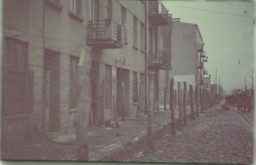
Canadian troops of the 'B' Company, North Shore (New Brunswick) Regiment take cover on June 6, 1944, or D-Day.
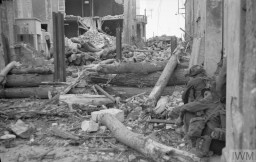
Candles mark the railway tracks leading to the Auschwitz camp during the commemoration of the 60th anniversary of the liberation of the camp. Poland, January 27, 2005.

Medical corpsmen of the US 71st Infantry Division, 3rd US Army look on as captured German soldiers remove bodies from inside a barracks in Gunskirchen. In the foreground, a Jewish girl lies huddled in the straw on the floor of the barracks. Gunskirchen, Austria, May 7, 1945.
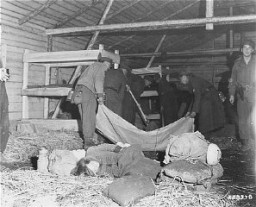
Jewish resistance fighters who were captured by SS troops during the Warsaw ghetto uprising. Warsaw, Poland, April 19-May 16, 1943. The original German caption reads: "These bandits offered armed resistance."
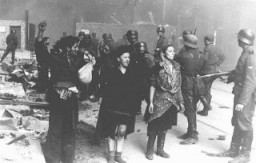
German soldiers arrest Jews during the Warsaw ghetto uprising. Poland, May 1943. The Warsaw ghetto uprising began on April 19, 1943, after German troops and police entered the ghetto to deport its surviving inhabitants. By May 16, 1943, the Germans had crushed the uprising, deported surviving ghetto residents, and left the ghetto area in ruins.
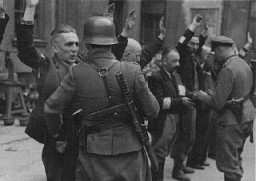
The sign erected by the 9th Armored division on the Ludendorff bridge after its capture. March 11, 1945. US Army Signal Corps photograph taken by W. Spangle.
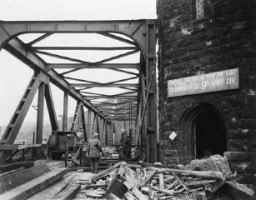
Refugee passengers of the SS Quanza sent a large bouquet of red roses and this message to First Lady Eleanor Roosevelt to thank her for her help. The First Lady made sure President Roosevelt saw both the flowers and the card, which were displayed prominently outside his bedroom.
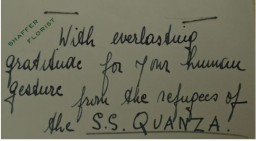
Caricature of Nuremberg International Military Tribunal defendant Alfred Rosenberg, by the German newspaper caricaturist Peis. Nuremberg, Germany, October 1, 1946.
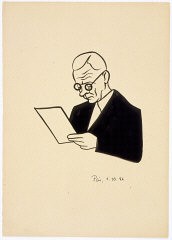
Soon after liberation, a camp survivor receives medical care. Bergen-Belsen, Germany, after April 15, 1945.
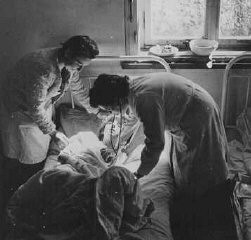
Soon after liberation, British medical officers begin disinfection of camp survivors. Bergen-Belsen, Germany, May 1945.
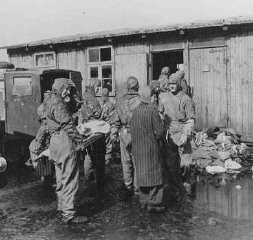
Survivors of the Wöbbelin camp wait for evacuation to an American field hospital where they will receive medical attention. Germany, May 4-6, 1945.
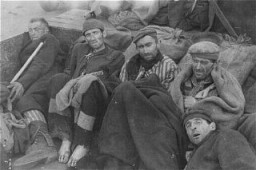
Survivors in Wöbbelin board trucks for evacuation from the camp to an American field hospital for medical attention. Germany, May 4–5, 1945.
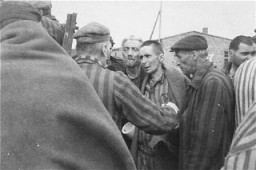
Carl Goerdeler, former mayor of Leipzig and a leader of the July 1944 conspiracy to kill Hitler, stands trial before the People's Court in Berlin. He was condemned and executed at Ploetzensee prison on February 2, 1945. Berlin, Germany, 1944.
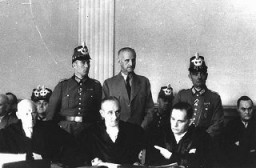
Catholic clergy and Nazi officials, including Joseph Goebbels (far right) and Wilhelm Frick (second from right), give the Nazi salute. Germany, date uncertain.
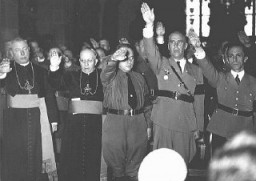
Members of the Chug Ivri (Hebrew Club) in Berlin celebrate Purim with food and song. On the wall is an advertisement for Juedische Rundschau, the newspaper of the German Zionist movement. Berlin, Germany, 1935.
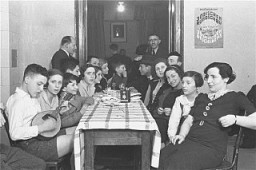
Members of Chug Ivri (Hebrew Club) of Berlin celebrate Purim. While the man in the tallis (prayer shawl) chants the story of Purim from the scroll, a young boy stands ready to use his grogger (noisemaker) to drown out the recitation of the name of Haman, the villain of the story. Berlin, Germany, 1935.
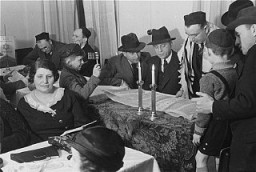
Blanka (right) with her daughter, Shelly, after Shelly's wedding. New York, 1974.
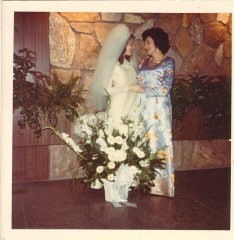
Naftali Saleschutz (Norman Salsitz) prepares cement for the foundation of a sukkah (a hut-like structure used to celebrate the Jewish holiday of Sukkot). Kolbuszowa, Poland, 1937.
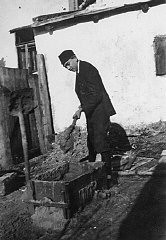
Adolf Hitler and other participants in the Hitler Putsch, during the annual anniversary celebration of his failed attempt to seize power. Behind Hitler stand Rudolf Hess (left) and Heinrich Himmler. Munich, Germany, November 9, 1934.
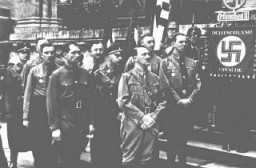
Cemetery at Hadamar. This photograph was taken toward the end of the war. Hadamar, Germany, April 1945.
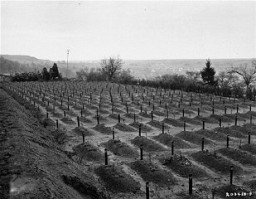
Closing ceremonies of the 4th Winter Olympic Games. Garmisch-Partenkirchen, Germany, February 16, 1936.
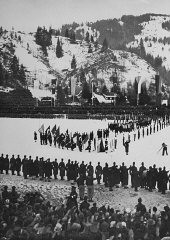
British prime minister Neville Chamberlain (left), German chancellor Adolf Hitler (center), and French premier Edouard Daladier (right) meet in Munich to determine the fate of Czechoslovakia. Germany, September 30, 1938.
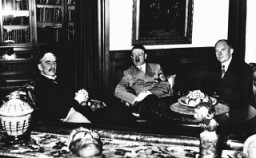
During an inspection by US Army chaplains of the newly liberated Buchenwald concentration camp, G. Bromley Oxnam (right) views a demonstration of how prisoners were tortured in Buchenwald. Oxnam was the Methodist bishop of New York and President of the Federated Council of Churches of Christ in America. Buchenwald, Germany, April 27, 1945.
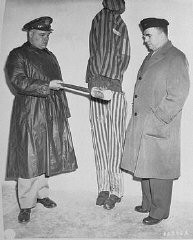
US Brigadier General Telford Taylor (front right), chief of counsel, sits at the prosecution table with his staff during the reading of charges against the defendants in the RuSHA Trial. October 10, 1947.
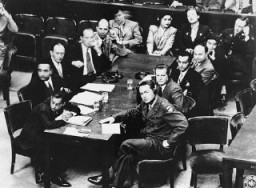
We would like to thank Crown Family Philanthropies, Abe and Ida Cooper Foundation, the Claims Conference, EVZ, and BMF for supporting the ongoing work to create content and resources for the Holocaust Encyclopedia. View the list of donor acknowledgement.